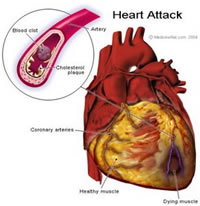Does having a heart attack in your medical history mean you are uninsurable?
Assessing Heart Damage and Insurability

How fully a person recovers from a heart attack is dependent upon what part of the heart and how much of the heart is permanently damaged. The extent of the damage will, in turn, determine the course of recovery, be it surgical, medicinal, rehabilitative including lifestyle change. Insurers need to build a case that certifies that the person recovering from a heart attack is doing everything possible to prevent a future attack. Document your heart health by supplying the insurer with:
- EKG reports
- Regular medical follow-up
- Medication list
- Method of monitoring and controlling blood pressure and cholesterol
- Lifestyle improvements: quit smoking, cardiac rehabilitation, exercise, healthy diet
In the best case scenario, of a mild heart attack with few or no complications, a person may be insurable as quickly as three to six months. In some cases of complicated heart attacks, where the health of the heart is in question, an insurer may request additional EKG or stress test findings to support supplied documentation. Worst case scenarios are faced by individuals who are still experiencing chest pain, arrhythmias, shortness of breath, circulatory discomfort or weakness following treatment after their heart attacks. These individuals are probably uninsurable.
Other related medical conditions (or medical terminology) include Heart Disease, Coronary Artery Disease, CAD, Coronary Angioplasty, MI, Atherosclerosis, Heart By-Pass Surgery. Read below for more information on receiving a term life insurance quote from a life insurance specialist with these medical conditions.
Who Is at Risk for Heart Attack
There are numerous risk factors that lead to heart attacks, some inherited and others preventable. Heredity, or bad genes, is a leading cause of coronary artery disease which can lead to heart attack. High blood pressure, unhealthy cholesterol and diabetes can run in families or can result from stress or poor dietary choices, however, these conditions are manageable with medication and lifestyle changes. Some individuals are at higher risk due to elevated levels of an amino acid called homosysteine, or fibrinogen which is involved in blood clotting, or C-reactive protein which is linked to inflammation. Men appear to be at greater risk for heart attack than women and aging is also a risk factor. Smoking and a high-fat diet are risk factors that are corrected with lifestyle change.
The Challenge of Detecting a Heart Attack
Heart attacks can be brutally obvious or silent. According to Medline Plus, heart attacks may include some or all of the following symptoms:
- Shortness of breath
- Nausea or vomiting
- Anxiety
- Coughing
- Fainting
- Lightheadedness or dizziness
- Palpitations (feeling like your heart is beating too fast)
- Sweating, which may be extreme
In addition to the aforementioned symptoms, severe heart attacks can present with sudden chest pain, described as feeling like a tight band is around or a heavy object is on the chest. The pain can be limited to one part of the body or can move from chest to arms, shoulder, neck, teeth, jaw, belly area, or back. The pain of a heart attack usually lasts longer than twenty minutes and relief is not experienced following rest or from taking a medication called nitroglycerin. Damage from a heart attack is documented by abnormal findings on a test called an electrocardiograph (EKG) and from elevations in cardiac enzymes. This type of heart attack usually occurs when coronary arteries narrow due to a build up of plaque. This condition is known as atherosclerosis. When a piece of plaque breaks loose from the wall of an artery it can cause blood clots to form and lodge in smaller parts of the coronary artery. The clots prevent oxygenated blood from reaching the heart and the heart muscle begins dying from suffocation.
Silent heart attacks mimic the symptoms of indigestion or may cause only minor discomfort. Since the symptoms are misinterpreted, many people fail to seek medical treatment. These attacks are referred to as “silent myocardial infarctions” and the resulting heart damage remains undiagnosed until the unsuspecting person undergoes an EKG test for another reason and abnormal findings are revealed. Often times, people applying for insurance have medical exam with an EKG, which may lead to a diagnosis.
Fighting Back a Heart Attack
When a person has a severe heart attack and appears in an emergency room and is hospitalized, there are several courses of medical treatment, which may be performed alone or in combination when a heart attack is suspected or confirmed. A clot dissolving medication may be given to interrupt a heart attack that is in progress. A procedure called angioplasty in which a balloon-like device, called a stent, is inserted using a catheter into a blocked artery to may be necessary to open the artery. In the aftermath of major heart attacks, or as a preventive measure in patients with severe artherosclerosis, coronary artery bypass surgery (CABG) to remove and replace the blocked arteries may be recommended.
Following a heart attack, patients are monitored using an electrocardiogram (ECG) machine to look for irregular heart beats called arrhythmias. Depending upon the EKG readings, a patient may be started on blood thinners, called thrombolytic therapy, through an intravenous line in a vein. In addition to medicines, fluids will be administered through the IV and a urinary catheter, a thin tube, will be inserted into the bladder to monitor the body’s fluid output. Patients will also be given oxygen, even when their oxygen levels are normal, to relieve the heart from the burden of being the sole supplier of oxygen to the body.
How Can MEG Financial Help?
At MEG Financial, we have worked with many individuals across the country that have had alcohol related histories and have helped many obtain fairly priced life insurance. A number of these clients previously attempted to buy life insurance elsewhere but were either turned down or asked to pay a significantly higher rate. Our experience helping others with alcohol related problems is invaluable to you in identifying the insurance company that will treat you most fairly.
For more specific information or to obtain a custom quote, call MEG Financial today at (877) 583-3955. You may also submit this short form and an independent insurance agent will personally contact you to go over any questions or other concerns.

 Speak with an experienced advisor!
Speak with an experienced advisor! 


